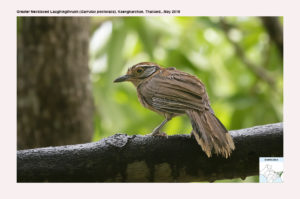Greater Necklaced Laughingthrush

Greater-Necklaced Laughingthrush Garrulax pectoralis
Etymology:
- Garrulax : Latin word garrulous -babbling, chattering; ax -inclining towards
- Pectoralis : Latin word for Breast
Vernacular Names: Ben: Badapenga, Dafla: Poreri, Purirhi, Lepcha: Ol-pho, Bhutia: Piang-kam
Distribution inIndia: Resident of Himalayas and North East in India.
Description: Size of 26·5–34·5 cm; Wt. of 105–170 g. It is a large laughingthrush with dark eyes, bold necklace and dark primary coverts. The nominate race has olive-tinged mid-brown on crown and upperparts, hind collar and upper mantle are rufescent, wing fringes and central tail feathers similar to upperparts but outer primaries are fringed greyer, primary coverts are darker than rest of wing, outer tail feathers are blackish-brown distally with broad white tips. The lores and side of forehead are whitish to buff, narrow whitish postocular supercilium from eye to above rear of ear-coverts. The ear-coverts are whitish, variably streaked dark greyish to almost entirely black, black eyestripe and moustachial stripe meeting on neck side and extending as broad black band down breast side and across breast forming a prominent necklace that is narrowest at mid-breast. The chin to upper breast area is pale buffy whitish; area below necklace is whitish, with rufous wash on flanks and vent. The iris is brown to crimson, orbital skin is golden-yellow to yellowish-green; bill is blackish, lower mandible has greyer basal half; legs are slate-grey to horn-green. The sexes are similar. The juvenile is warmer above and sometimes also on wings than adult, with pale tips and fringes of primary coverts, and has necklace duller or less distinct, eyering is duller. The race subfusus is paler and greyer-tinged above than nominate, with hindcollar narrower and paler, necklace narrower, underparts more uniform pale rufescent buff, tail with buff-tinged tips; race robini is smaller, with slightly darker, richer upperparts, hind collar is narrower and more rufous-chestnut, necklace very narrow or broken in centre, lower breast and belly are uniform rufescent buff; race picticollis resembles robini in size and upperpart colour, but hind collar is much broader and more rufous-chestnut, more prominent whitish lores extending over and under eye, black on neck side tipped greyish and that on necklace tipped buff; race semitorquatus is smallest, like nominate above but washed more olive, hind collar is narrow and rather weak, necklace variably broken in center, underparts are whitish to very pale buffy white, tail tips are deep buff.
Habitat: It is found in broadleaf evergreen forest, mixed deciduous forest and mixed broadleaf-coniferous forest, secondary growth, cut-over scrub, bamboo, plantations. It is found up to 2000 m.
Food Habits: It eats insects and some fruits. It is gregarious in flocks often in association with white-crested laughingthrush and Lesser Necklaced Laughingthrush or other laughingthrushes where ranges overlap and also with Common Green Magpie and Greater Racquet-tailed Drongo. It forages mainly on forest floor; sometimes moves up to middle storey.
Breeding Habits: They Breed in Feb–Aug. They are multi-brooded. The nest is a large, broad, bulky, shallow cup or saucer, made of dead bamboo or other leaves, roots, moss, bracken, grasses, twigs, sticks, weed stems, creeper stems and tendrils, lined with rootlets, fine grass stems, fine twigs and tendrils, placed in bush, small tree or bamboo clump, and sometimes among the grass. They lay a clutch 3–7 eggs. Brood parasitism is done by Chestnut-winged Cuckoo.